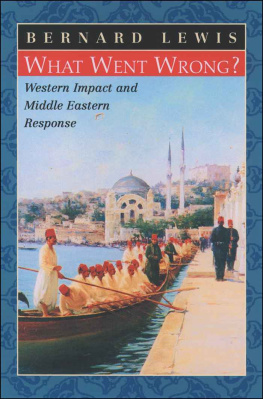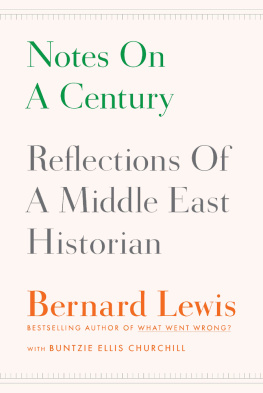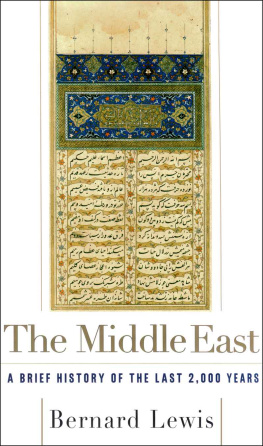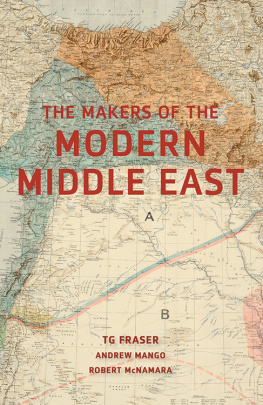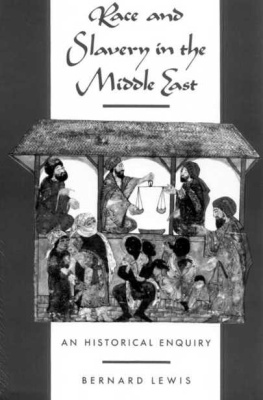Bernard Lewis - The Shaping of the Modern Middle East
Here you can read online Bernard Lewis - The Shaping of the Modern Middle East full text of the book (entire story) in english for free. Download pdf and epub, get meaning, cover and reviews about this ebook. year: 2007, genre: History. Description of the work, (preface) as well as reviews are available. Best literature library LitArk.com created for fans of good reading and offers a wide selection of genres:
Romance novel
Science fiction
Adventure
Detective
Science
History
Home and family
Prose
Art
Politics
Computer
Non-fiction
Religion
Business
Children
Humor
Choose a favorite category and find really read worthwhile books. Enjoy immersion in the world of imagination, feel the emotions of the characters or learn something new for yourself, make an fascinating discovery.
- Book:The Shaping of the Modern Middle East
- Author:
- Genre:
- Year:2007
- Rating:5 / 5
- Favourites:Add to favourites
- Your mark:
- 100
- 1
- 2
- 3
- 4
- 5
The Shaping of the Modern Middle East: summary, description and annotation
We offer to read an annotation, description, summary or preface (depends on what the author of the book "The Shaping of the Modern Middle East" wrote himself). If you haven't found the necessary information about the book — write in the comments, we will try to find it.
The Shaping of the Modern Middle East — read online for free the complete book (whole text) full work
Below is the text of the book, divided by pages. System saving the place of the last page read, allows you to conveniently read the book "The Shaping of the Modern Middle East" online for free, without having to search again every time where you left off. Put a bookmark, and you can go to the page where you finished reading at any time.
Font size:
Interval:
Bookmark:

THE MODERN MIDDLE EAST
OTHER BOOKS BY THE AUTHOR
The Arabs in History (1950, new ed. 1993)
The Emergence of Modern Turkey (1961, rev. ed. 1968)
Istanbul and the Civilization of the Ottoman Empire (1963)
The Assassins (1968)
The Muslim Discovery of Europe (1982)
The Jews of Islam (1984)
The Political Language of Islam (1988)
Race and Slavery in the Middle East: An Historical Enquiry (1990)
Islam in History (1993)
Islam and the West (1993)

THE MODERN
MIDDLE EAST

Bernard Lewis

The nucleus of this book is a series of six public lectures delivered at Indiana University, Bloomington, between 19 March and 23 April 1963. Their theme is the relations between the Middle East and the West-the impact of both Western action and Western civilization on the Islamic peoples and societies of the Middle East, and the successive phases of Middle Eastern response. In the first chapter I have attempted to define the Middle East as a historical, geographical, and cultural entity; in the second, to show what the West has meant and means to Middle Easterners and to trace the processes of Western intrusion, influence, domination, and partial withdrawal. The next three chapters deal with political and intellectual movements in the Middle East in recent and modern times, in three main groups-liberal and socialist, patriotic and nationalist, and Islamic. The final chapter examines the place and role of the countries of the Middle East in international affairs and concludes with a consideration of some of the factors affecting Western policy toward them.
During the nearly thirty years that have passed since the delivery and publication of these lectures, vast changes have taken place in both the world and the region. The Cold War flared to a climax, inflamed the Middle East, and ended. The Soviet Union itself disintegrated, and the vast Muslim lands that had been conquered by the czars and incorporated into the Russian empire recovered their independence and seemed to be returning to the historic Middle East of which they had once been a part. Arabs and Israelis fought several more wars. Palestinians, despairing of active help from the Arab states, formed their own organization. An Egyptian statesman initiated and accomplished the first peace treaty between Israel and an Arab state, and a process was begun which might in time lead to a more general peace in the region. A dictator in Iraq invaded and annexed a neighboring Arab state, thus flouting the rules of both inter-Arab and international coexistence and provoking a massive intervention and involvement of the United States. A revolution in Iran evoked responses all over the Middle East and indeed all over the Islamic world, and transformed the region through the emergence of a new regional power and a new Islamic ideology, radical in both its objectives and its methods.
In all three major themes examined in the lectures-religion, nationhood, and the quest for freedom-far-reaching and significant changes took place, including both successes and failures, both the return to old traditions and the pursuit of new ideas.
In this new edition, I have tried to present and interpret the major changes that have taken place, the new perceptions of freedom, both national and personal, and the attempts being made to achieve it, the changing content and significance of national and patriotic loyalties, and the resurgence of religious and communal identities and commitments. In discussing these processes, I have tried to situate them in both a global and a regional context-in the shifting interplay of regional and global powers on the one hand, and in the far-reaching changes in Middle Eastern economies and societies on the other.
The study of recent and contemporary history presents special problems to the historian. There is the obvious difficulty of the fragmentary and usually secondary quality of his documentation, but in compensation there is the immediacy of his experience of the events of his own time. This in turn brings another danger-that of the historian's own involvement and commitments. We are all, including historians, the children of our own time and place, with loyalties, or at least predispositions, determined by country, race, gender, religion, ideology, and economic, social, and cultural background. Some have argued that since complete impartiality is impossible, the historian should abandon the attempt as false and hypocritical, and present himself frankly as a partisan of his cause. If his cause is just, according to this view, his story will to that degree be authentic. If his cause is unjust, his story will be flawed and should be dismissed accordingly.
In this book, I have adhered to a different view: that the historian owes it to himself and to his readers to try, to the best of his ability, to be objective or at least to be fair-to be conscious of his own commitments and concerns and make due allowance and, where necessary, correct for them, to try to present the different aspects of a problem and the different sides to a dispute in such a way as to allow the reader to form an independent judgment. Above all, he should not prejudge issues and predetermine results by the arbitrary selection of evidence and the use of emotionally charged or biased language. As a famous economist once remarked, "Complete asepsis is impossible, but one does not for that reason perform surgery in a sewer."
The reader will judge how far I have succeeded in my antiseptic precautions to avoid infection. I derive some reassurance from the reception of the first edition of this book, which, among other languages, was translated and published in both Hebrew and Arabic. The Hebrew version was sponsored by the publishing house of the Israeli Ministry of Defense; the Arabic version by the Muslim Brothers. The Arabic translation appeared in two editions: a full booklength version and a shortened version in pamphlet form that was hawked in the vicinity of mosques. I hope I may be forgiven for feeling that a presentation which both Israeli Defense officials and Muslim Brothers thought worthy of publication under their auspices may have achieved some level of objectivity. The translator of the Arabic version, in his introductory remarks, observes that the author of this book is one of two things: a candid friend or an honorable enemy, and in either case, one who does not distort or evade the truth. I am content to abide by that judgment.

Font size:
Interval:
Bookmark:
Similar books «The Shaping of the Modern Middle East»
Look at similar books to The Shaping of the Modern Middle East. We have selected literature similar in name and meaning in the hope of providing readers with more options to find new, interesting, not yet read works.
Discussion, reviews of the book The Shaping of the Modern Middle East and just readers' own opinions. Leave your comments, write what you think about the work, its meaning or the main characters. Specify what exactly you liked and what you didn't like, and why you think so.





